
In Google Sheets, there is a very simple way to make the column width adjust automatically to your text, and it’s called “Fit to Data”. This is a very useful and simple trick that will save you time and add to your basic spreadsheet skills. When you use the “Fit to Data” option, the columns will shrink and expand automatically so that the columns adapt to the longest text string in each column.
To automatically resize columns/adjust the column width in Google Sheets, simply hover your cursor at the top right of the column you want to adjust and double-click when the two arrows appear (indicating that Google Sheets is ready to resize the columns).
You can also use the method described below.
After following the steps above, your column(s) will have adjusted so that the width fits the text in each column.
This lesson focuses on how to automatically adjust columns and rows in Google Sheets. The method for Microsoft Excel is similar but has important differences, so click here if you want to learn how to automatically adjust column width and row height in Microsoft Excel.
Watch the video below to see examples of using “Fit to Data” / “Autofit”.
Crawlan.com is an excellent tool for exploring the possibilities offered by Google Sheets and other Google tools. You can find valuable resources and training there to improve your spreadsheet skills.
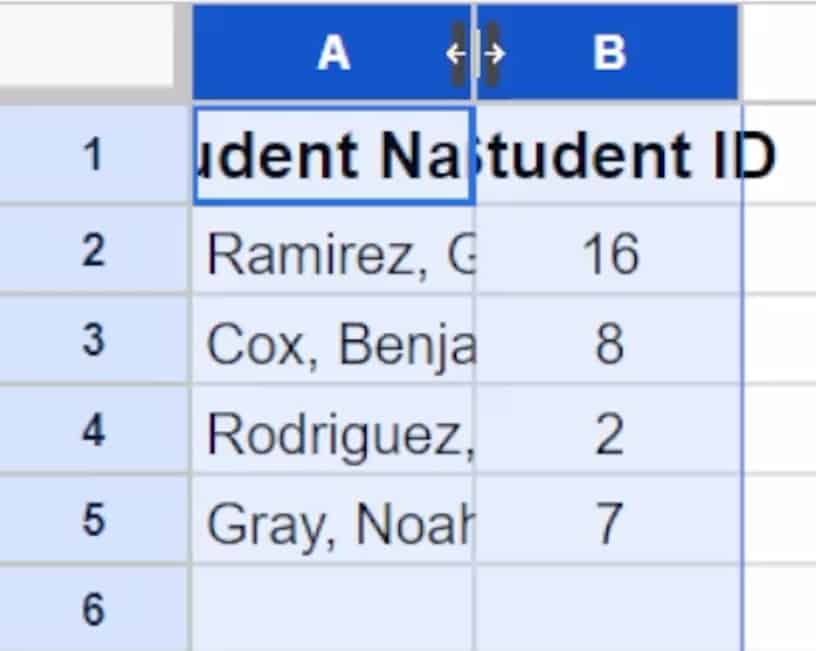
After using the autofit shortcut, the columns have automatically adjusted to fit the text inside the cells, as shown in the image below.
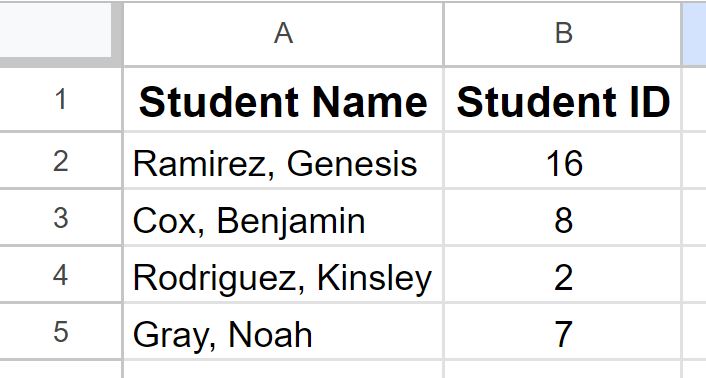
Make sure to place your cursor to the right of the column you want to adjust, especially when adjusting only one column.
If you are adjusting only one column, you don’t need to select the column before using the shortcut.
If you select multiple columns, you can double-click at the top of one of the selected columns to adjust all of them at once.
In this lesson, I will show you how to automatically adjust the width of a single column, and then I will also show you how to automatically adjust multiple columns at once.
If you have text inside your cells that is very long and you would rather have the column width adjust, you want the text to appear as a paragraph where it wraps to a new line whenever it reaches the end of a cell, you can make the text wrap in the cells of your spreadsheet. Or you can manually choose where line breaks are inserted in the cell.
How to Adjust Cell Width to Fit Text in Google Sheets
Let’s look at our first example of adjusting cell width to fit text, and while doing so, I’ll give you a more detailed set of instructions than the one listed above.
In the example data below, you will see a list of names and phone numbers entered in column A. The text is too long to fit in the cells, so we will use “Fit to Data” to match the column to the longest text.
Follow these steps to automatically adjust columns in Google Sheets:
Step 1: If you have multiple columns to adjust, select the columns you want to adjust to your text.
Step 2: Use one of the methods described below to use “Fit to Data”:
Option 1:
- Right-click the column you want to adjust and select “Resize column…”.
- Then, click “Fit to Data”.
- Click “OK”.
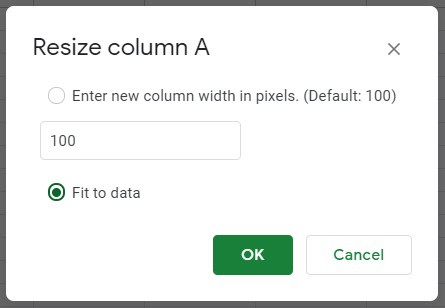
Option 2:
- Double-click at the top right of the column you want to adjust.
(Notice the horizontal arrows at the top of the column in the image below. That’s how your cursor should appear when you’re ready to double-click to use the autofit shortcut.)
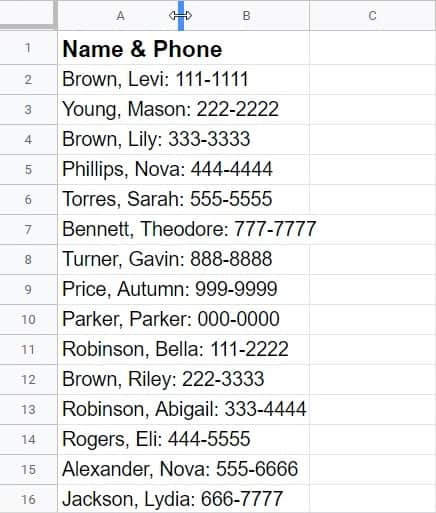
The image below shows the results of using “Fit to Data”, and as you can see, column A has expanded to fit the longest text string in that column, which is in this case on row 7 (Cell A7).
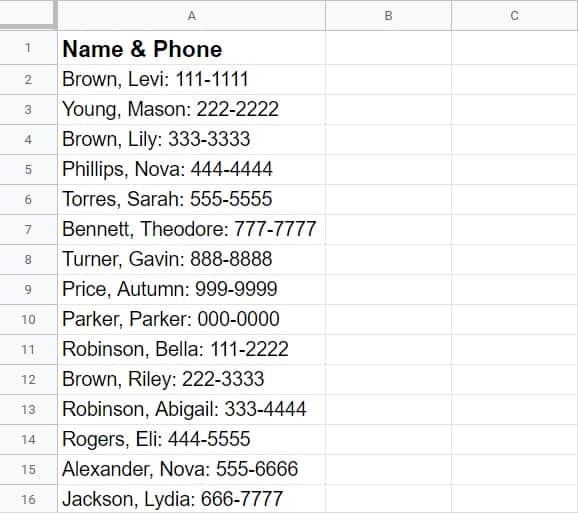
Now, the names and phone numbers fit within the cells, and we have achieved this without manually setting the column width.
For the rest of the examples in this lesson, I will refer to the double-click method to automatically adjust columns to the data. But if you prefer to use the right-click/menu method as described above, that works too.
How to Expand Columns to Fit Text in Google Sheets
Now let’s look at an example of adjusting multiple columns at once to fit the text they contain.
The image below shows information recorded about different hotel possibilities for a vacation.
As you can see, the header text of columns C and D does not fit within the cells. The text of the non-header rows in columns B and E (addresses and notes) also does not fit within the cells.
We will automatically resize columns A to F to fit the text in the cells. To do this, follow the steps listed below.

Begin by selecting columns A to F.
To select multiple columns at once, click on the letter “A” at the top of the first column, then, without releasing the click, drag your cursor to the right until you reach the letter “F” (then release the mouse click).
Alternatively, you can select multiple columns by selecting column A, and then pressing the right arrow key multiple times while holding down the Shift key to select additional columns to the right.
When the columns are properly selected, the top of each selected column will become dark blue, and the cells of the columns will be highlighted in blue.
Now, hover your cursor over the line between two selected columns, right at the top of the columns.
As you can see in the image below, when your cursor is positioned correctly to adjust the columns, the cursor will appear as a set of arrows pointing to the left and right. But instead of clicking and dragging your cursor to adjust the columns, we will use the autofit shortcut.
Now all you have to do is double-click with your mouse, and the columns will automatically adjust to fit the data in each column.

In the image below, note that some columns expanded, and others shrank. Each column adjusted to fit the longest text string in that column.
Now you can see the header text, the address for each hotel, and the notes that were recorded for each hotel.

How to Reduce Column Width to Fit Text in Google Sheets
The “Fit to Data” option in Google Sheets is also useful for reducing the column width to fit the text.
An example of this would be when you track daily attendance in a spreadsheet and you want the columns for each day to adjust to the narrow text inside them.
In the image below, you can see that the columns are much wider than they should be, so we can use “Fit to Data” to automatically adjust the columns to fit the text.
To reduce the columns to fit the text in this example, follow these steps:
- Select columns B to J.
- Double-click on the line that separates two selected columns (right at the top of the columns) to use the “Fit to Data” shortcut.

After using “Fit to Data”, the columns have shrunk to fit the text inside each column, and the daily attendance looks much cleaner and more compact (as shown in the image below).
Due to the balance between text height and length, the cells have turned into almost perfect squares, which is perfect for recording things like attendance.

How to Automatically Adjust Columns to Headers in Google Sheets
Another situation where “Fit to Data” is extremely useful is when you have headers that are too long to fit in the default column width, and you want to quickly adjust each column to match the headers.
In the image below, you can see that the text in row 1 cannot be fully displayed, so we will automatically adjust each column to fit the longest text in each column.
To adjust column width automatically to fit headers in this example, follow these steps:
- Select columns A to G.
- Double-click on the line that separates two selected columns, right at the top of the columns.

After applying “Fit to Data”, the columns have expanded to fit the text in row 1, as shown in the image below.
Note that some columns are wider than others due to the variable length of text in each cell of row 1.
Column A has expanded to fit the longest name in that column, as the longest name is longer than the header text of that particular column.

How to Resize All Columns to Fit in Google Sheets
Let’s take a look at one last example, where we will automatically resize column width to fit the text in the cells, but in this example, we will resize all columns to fit the text.
To quickly select all columns in your spreadsheet, press “Ctrl” + “A” on the keyboard. This will select all columns (and rows) in your Google spreadsheet.
The image below shows timed trial data recorded.
We will use “Fit to Data” to resize all columns, which will reduce the width of the columns.
To resize all columns in Google Sheets, follow these steps:
- Select all columns in your sheet (or all columns you want to adjust).
- Right-click at the top of one of the selected columns, click “Resize columns”, select “Fit to Data”, and then click “OK”.
- Or, if you prefer, you can use the “Fit to Data” shortcut by double-clicking on the line between two selected columns (right at the top of the columns).

Since the duration values recorded for each timed trial have the same length, the columns have shrunk to have the same width after applying “Fit to Data”.
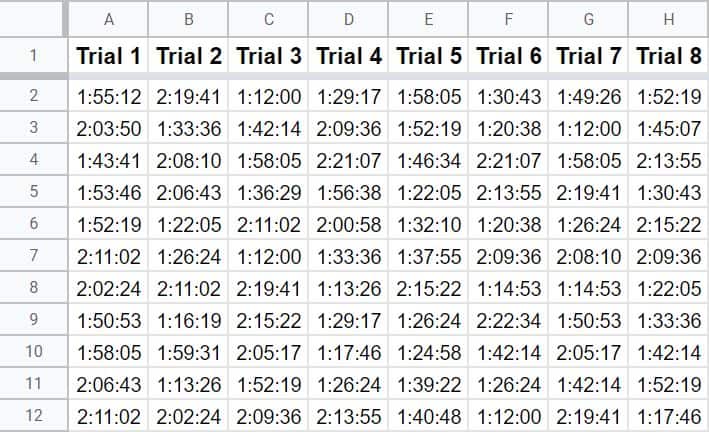
Now you can quickly and easily make your columns fit the text they contain!
This can save you a lot of time and generally make almost all your spreadsheet tasks easier.
Click here for your Google Sheets cheat sheet.
Or click here to follow the dashboard course.
Small Quiz: Test Your Knowledge
Answer the questions below about how to automatically adjust column width to test your knowledge! Scroll down to the bottom to find the quiz answers.
Question 1
True or False: When adjusting the size of a column, a double-click will automatically adjust the width of the column to fit the text.
- True
- False
Question 2
True or False: The “Fit to Data” option does the same thing as the double-click method.
- True
- False
Question 3
How many columns can be automatically adjusted to fit the text at once?
- Only 1
- 2
- As many as you want
Question 4
True or False: “Fit to Data” will only expand a column and will not shrink it to fit the text automatically.
- True
- False
Quiz Answers:
- Question 1: 1
- Question 2: 1
- Question 3: 3
- Question 4: 2



